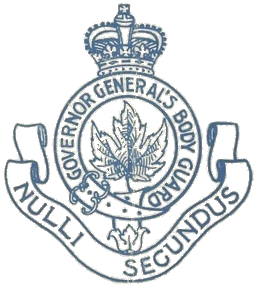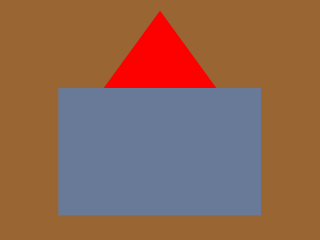
The Governor General's Horse Guards is an armoured cavalry regiment in the Primary Reserve of the Canadian Army. The regiment is part of 4th Canadian Division's 32 Canadian Brigade Group and is based in Toronto, Ontario. It is the most senior reserve regiment in Canada, and the only household cavalry regiment of Canada's three household units.

The Governor General's Body Guard was a royal guard regiment of the Canadian Army that formed part of the country's household troops. The Body Guard was the senior regiment of the Canadian Army and the equivalent of the British Army's Life Guards and Royal Horse Guards. In 1936 the regiment amalgamated with the Mississauga Horse to become The Governor General's Horse Guards.
The Prince Albert Volunteers (PAV) is the name of two historical infantry units headquartered in Prince Albert, Saskatchewan. The unit was first raised in 1885 during the North-West Rebellion and disbanded after hostilities ceased. In the 20th century, the unit was operational from 1913 to 1936 and 1941 to 1946. The PAV is now incorporated by amalgamation in the North Saskatchewan Regiment (N Sask R).
The Peel and Dufferin Regiment was an infantry regiment of the Non-Permanent Active Militia of the Canadian Militia. First organized in 1866 as the 36th Peel Battalion of Infantry, the regiment was reorganized in 1900 as the 36th Peel Regiment. Following the First World War, the regiment was reorganized again in 1920 as The Peel Regiment and for the final time in 1923 as The Peel and Dufferin Regiment. In 1936, the regiment was Amalgamated with The Lorne Rifles (Scottish) to form The Lorne Scots.
Canadian Mounted Rifles was part of the designation of several mounted infantry units in Canada in the late 19th and early 20th centuries.
The 15th Canadian Light Horse was a light cavalry regiment of the Non-Permanent Active Militia of the Canadian Militia. First formed in 1905 as the 15th Light Horse, the regiment was redesignated in 1920 as the 15th Canadian Light Horse. In 1936, the regiment was Amalgamated with The South Alberta Horse to form the 15th Alberta Light Horse.

The 4th Battalion, Canadian Mounted Rifles was authorized on 7 November 1914 as the 4th Regiment, Canadian Mounted Rifles, CEF and embarked for Britain on 18 July 1915. It disembarked in France on 24 October 1915, where it fought as part of the 2nd Brigade Canadian Mounted Rifles until 31 December 1915, when it was converted to infantry and allocated to the 8th Canadian Infantry Brigade, 3rd Canadian Division. The regiment was redesignated the 4th Battalion, Canadian Mounted Rifles, CEF on 1 January 1916 and was disbanded on 6 November 1920.
The Oxford Rifles were an infantry regiment of the Non-Permanent Active Militia of the Canadian Militia. In 1954, the regiment was amalgamated with The Canadian Fusiliers to form The London and Oxford Fusiliers.
The Prince Edward Island Light Horse was a cavalry regiment of the Non-Permanent Active Militia of the Canadian Militia. First authorized in 1901 as an Independent Squadron of the Canadian Mounted Rifles, it became a full regiment in 1903 and received its regimental number in 1914. The regiment served until 1946 when it was amalgamated with The Prince Edward Island Highlanders to form what is now The Prince Edward Island Regiment (RCAC).
The 2nd Dragoons was a cavalry regiment of the Non-Permanent Active Militia of the Canadian Militia. In 1936, the regiment was Amalgamated with the 10th Brant Dragoons to form the 2nd/10th Dragoons – today now part of the 57th Field Artillery Regiment, RCA.
The Border Horse was a cavalry regiment of the Non-Permanent Active Militia of the Canadian Militia. In 1935, the regiment was amalgamated with the 12th Manitoba Dragoons.
The Manitoba Horse was a cavalry regiment of the Non-Permanent Active Militia of the Canadian Militia. First formed in 1912 as the 32nd Light Horse, the regiment was redesignated later that same year as the 32nd Manitoba Horse and again in 1920 as The Manitoba Horse. In 1936, the regiment was amalgamated with The Fort Garry Horse.
The Lorne Rifles (Scottish) was an infantry regiment of the Non-Permanent Active Militia of the Canadian Militia (now the Canadian Army). First raised in the 1860s, the regiment was known for most of its existence as The Halton Rifles until 1931 when the regiment was renamed as The Lorne Rifles (Scottish). In 1936, the regiment was amalgamated with The Peel and Dufferin Regiment to form The Lorne Scots (Peel, Dufferin and Halton Regiment).
The Manitoba Mounted Rifles was a cavalry regiment of the Non-Permanent Active Militia of the Canadian Militia and later the Canadian Army. In 1946, the regiment was converted to artillery.
The Victoria and Haliburton Regiment was an infantry regiment of the Non-Permanent Active Militia of the Canadian Militia. In 1936, the regiment was converted from infantry to artillery to become the 45th Field Battery RCA and now forms part of the 50th Field Artillery Regiment, RCA.
The Haldimand Rifles was an infantry regiment of the Non-Permanent Active Militia of the Canadian Militia. In 1936, the regiment was Amalgamated with The Dufferin Rifles of Canada to form The Dufferin and Haldimand Rifles of Canada.
The 16th Canadian Light Horse was a light cavalry regiment of the Non-Permanent Active Militia of the Canadian Militia. First formed in 1905 as the 16th Mounted Rifles, the regiment was Redesignated in 1908 as the 16th Light Horse and again in 1920 as the 16th Canadian Light Horse. In 1936, the regiment was amalgamated with The Saskatchewan Mounted Rifles to form the 16th/22nd Saskatchewan Horse.
The Princess Louise Dragoon Guards was a heavy cavalry regiment of the Non-Permanent Active Militia of the Canadian Militia. First formed in 1872 as an independent cavalry troop, in 1903 it became a full regiment. In 1936, the regiment was amalgamated with the 4th Hussars of Canada to become the 4th Princess Louise Dragoon Guards.
The Royal Grenadiers was an infantry regiment of the Non-Permanent Active Militia of the Canadian Militia. The regiment was unique in its history as it was only one of two regiments in the Canadian Army to be designated as a Grenadier Regiment. In 1936, the regiment was Amalgamated with The Toronto Regiment to form The Royal Regiment of Toronto Grenadiers.
The Midland Regiment was an infantry regiment of the Non-Permanent Active Militia of the Canadian Militia and later the Canadian Army. The regiment was formed in 1936 by the Amalgamation of The Northumberland Regiment and The Durham Regiment. In 1954, The Midland Regiment was Amalgamated into The Hastings and Prince Edward Regiment.


